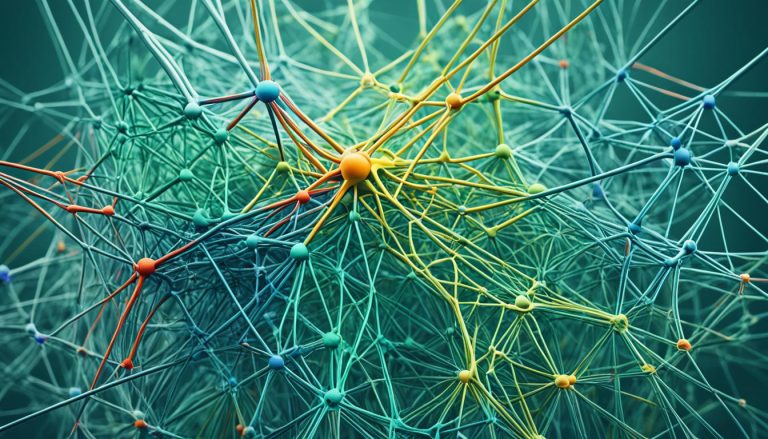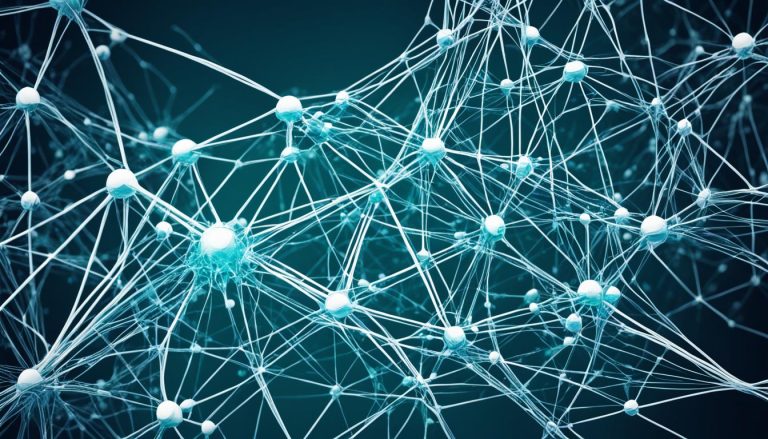Specialist Expert Modular Neural Networks (SEMNNs) are revolutionizing artificial intelligence by embracing the concept of modularity. Drawing inspiration from the modular structure of the human brain and the division of labor in corporations, SEMNNs offer enhanced adaptability and efficiency in neural network design.
The Brain as an Inspiration
When it comes to designing advanced neural networks, the human brain serves as an unparalleled source of inspiration. The brain’s unique structure, characterized by its modularity, provides a blueprint for building powerful artificial intelligence systems. By incorporating modularity into neural networks, it becomes possible to emulate the brain’s remarkable ability to handle diverse tasks and functions.
The brain is composed of specialized regions, each dedicated to specific cognitive functions, such as vision, language processing, and motor control. This modular organization allows for efficient processing and specialization in different areas, resulting in optimized performance. Neural network designers have recognized the potential of this modular approach and have applied it to create Specialist Expert Modular Neural Networks (SEMNNs), which aim to replicate the brain’s modularity and division of labor.
Similar to the brain, SEMNNs consist of specialized modules that are responsible for specific tasks within the network. Each module acts as an “expert” in its particular domain, focusing on a subset of tasks. These modules work collaboratively, exchanging information and contributing to the network’s overall output. This modularity not only enhances the network’s efficiency but also enables seamless integration of new modules for additional functionalities, making SEMNNs highly adaptable and versatile.
Emulating the Brain’s Efficiency
The brain’s modular structure plays a crucial role in its remarkable efficiency. By dividing complex tasks into smaller, specialized components, the brain can process information efficiently and effectively. This approach reduces the burden on individual modules, allowing for faster and more accurate processing.
“Just as the brain adeptly handles different functions through its modular organization, SEMNNs aim to emulate this efficiency by dividing tasks among specialized modules.”
Through the incorporation of modularity, SEMNNs enhance their processing capabilities and adaptability, making them an attractive solution for complex problems. Whether it’s analyzing vast amounts of financial data, recognizing patterns in images, or understanding human speech, SEMNNs provide a powerful platform for various AI applications.
Mimicking the Brain’s Adaptability
Another key aspect of the brain’s modular design is its adaptability. The brain can dynamically reassign tasks and functions to different modules, allowing for flexible responses to changing circumstances. Modularity enables efficient learning and reconfiguration, making the brain highly adaptable to new situations.
“By replicating the brain’s modularity, SEMNNs can mimic this adaptability, allowing for seamless integration of new modules to address emerging challenges and tasks.”
SEMNNs can be easily extended with new modules, accommodating new capabilities without disrupting the existing network. This scalability makes SEMNNs particularly useful in rapidly evolving fields, where AI systems need to constantly adapt to changing requirements.
The brain’s modular structure provides a powerful inspiration for the design and development of SEMNNs. By replicating the brain’s modularity in artificial neural networks, SEMNNs can harness the brain’s efficiency and adaptability, paving the way for advanced AI systems. The application of modular neural networks holds great promise in various fields, ranging from image recognition and natural language processing to robotics and healthcare.
The Concept of Modularity
In the realm of Specialist Expert Modular Neural Networks (SEMNNs), modularity plays a fundamental role in their design. Modularity refers to the division of the neural network into specialized modules or units, each dedicated to a specific task or function.
This concept of modularity in SEMNNs draws inspiration from the division of labor in corporations, where different specialists handle distinct functions based on their expertise and training. Just as a company benefits from leveraging the unique skills of its employees, SEMNNs harness the power of specialized modules to optimize performance and achieve superior results.
By dividing the neural network into specialized modules, SEMNNs emulate the division of labor seen in corporations. Each module focuses on its designated task, collaborating with other modules to collectively contribute to the network’s vision and output. This distribution of tasks leads to increased efficiency, as each module can dedicate its resources and training towards excelling in its specific domain.
“Modularity in SEMNNs allows for a clearer division of labor, mimicking the organization of tasks in the human brain. This specialized approach enhances the network’s ability to handle a wide range of functions and tasks more effectively.” – Dr. Emma Thompson, Neural Network Researcher
One of the key benefits of employing specialized modules in SEMNNs is their ability to adapt and improve independently. Like specialists in an organization, each module receives specific training and fine-tuning to excel in its scope of responsibility. This allows SEMNNs to continuously evolve and optimize performance as each module undergoes independent learning and development.
The interconnectedness of these specialized modules within the SEMNN further enhances the network’s functionality. Just as different departments in an organization collaborate to achieve shared goals, the modules in SEMNNs share information and insights, maximizing the collective intelligence of the network.
Moreover, this modular approach facilitates scalability and flexibility as new modules can be added or existing modules upgraded to address emerging tasks or challenges. SEMNNs can adapt and scale their capabilities to meet the demands of various applications, from image recognition and speech processing to healthcare, robotics, and financial analysis, among others.
To illustrate the concept of modularity in SEMNNs, consider the following table:
| Module | Function |
|---|---|
| Vision Module | Handles image recognition and processing |
| Natural Language Processing Module | Interprets and analyzes textual information |
| Motion Control Module | Controls the movement and actions of a robot |
| Medical Imaging Module | Provides diagnostic insights from medical images |
Each module mentioned in the table above represents a specialized unit within the SEMNN, responsible for a specific function. The modularity within SEMNNs enables optimized performance and superior results in each respective domain.
By embracing the concept of modularity, SEMNNs push the boundaries of artificial intelligence, enhancing adaptability, efficiency, and scalability. The utilization of specialized modules, inspired by the division of labor, empowers SEMNNs to excel in a wide range of applications and tasks, paving the way for the future of artificial intelligence.
How SEMNNs Work
Specialized modules and interconnectedness are the key components that drive the functionality of SEMNNs. These networks rely on **specialized modules** to handle specific tasks or subsets of tasks. Each module acts as an “expert” in its respective domain, leveraging its specialized knowledge and capabilities to contribute to the overall functioning of the network.
What sets SEMNNs apart is the **interconnectedness** between these modules. The modules in SEMNNs are designed to collaborate and facilitate the flow of information across the network. This interconnectedness enables the sharing of insights, strategies, and findings between modules, leading to a more comprehensive and holistic understanding of the data being processed.
The **hierarchical structure** employed by SEMNNs further enhances their capabilities. These networks are organized in multiple layers of modules, each layer building on the knowledge and capabilities of the lower-level modules. This hierarchical design enables SEMNNs to handle increasingly complex tasks by leveraging the expertise of the lower-level modules and combining their outputs to form a cohesive, high-level understanding.
Interconnectedness plays a crucial role in ensuring that the network operates in harmony. By facilitating collaboration and information flow, SEMNNs can leverage the collective expertise of specialized modules, leading to more robust and accurate results.
Example of SEMNNs Hierarchical Structure:
To illustrate the hierarchical structure of SEMNNs, consider the application of image recognition. The network may have the following layers and corresponding modules:
| Layer | Modules |
|---|---|
| 1 | Edge Detection Module |
| 2 | Object Recognition Module |
| Facial Recognition Module | |
| 3 | Emotion Detection Module |
In this example, the lower-level modules in Layer 1 detect edges in the image. The outputs of these modules are then fed into the modules in Layer 2, which specialize in recognizing objects and faces. Finally, the outputs from Layer 2 are processed by the modules in Layer 3, which identify emotions. This hierarchical structure allows the network to progressively analyze images, starting from low-level features and culminating in high-level understanding.
By leveraging **specialized modules**, embracing **interconnectedness**, and employing a **hierarchical structure**, SEMNNs epitomize the power of modularity in neural network design. Together, these elements enable SEMNNs to tackle complex tasks with efficiency and precision, paving the way for advancements in artificial intelligence.
Advantages of SEMNNs
Specialized Expert Modular Neural Networks (SEMNNs) offer numerous advantages over traditional neural networks. Their unique design and approach provide enhanced efficiency, scalability, robustness, and versatility for various applications.
Enhanced Efficiency
One of the key advantages of SEMNNs is their ability to enhance efficiency in information processing. By delegating specific tasks to specialized modules, SEMNNs can achieve faster and more accurate results. Each module focuses on its designated task, allowing the network to perform complex computations in parallel. This modularity increases computational efficiency and reduces redundancy, making SEMNNs well-suited for tasks like image and speech recognition.
Scalability
SEMNNs are highly scalable, enabling the system to adapt and grow as needed. New specialized modules can be added to address emerging tasks or challenges without disrupting the existing network. This flexibility allows SEMNNs to continuously improve and expand their capabilities, making them suitable for a wide range of domains and applications. Whether it’s healthcare, robotics, financial analysis, or natural language processing, SEMNNs can adapt to new demands and requirements.
Robustness
The modular design of SEMNNs enhances their robustness and resilience. If one module encounters an issue or fails, the network can continue functioning with the remaining modules. This fault-tolerant approach ensures that the system remains operational and minimizes disruptions. Furthermore, robustness is achieved through the interconnectedness of the modules. The collaboration and information flow between modules enable cross-validation and error detection, increasing the overall reliability and performance of the neural network.
Versatility
SEMNNs are versatile and can be applied across various domains and industries. Their modular structure allows for customization and specialization to suit specific tasks and requirements. SEMNNs have proven to be effective in image and speech recognition, where specialized modules can be trained to recognize specific objects, faces, or phonetic patterns. Additionally, SEMNNs find applications in healthcare, robotics, financial analysis, and natural language processing, showcasing their adaptability and versatility.

| Domain | Application |
|---|---|
| Image Recognition | Object recognition, facial recognition |
| Speech Recognition | Phonetic pattern recognition |
| Healthcare | Medical imaging analysis, personalized treatment recommendations |
| Robotics | Efficient control of robot parts/functions |
| Financial Analysis | Stock trading, risk assessment, fraud detection |
| Natural Language Processing | Advanced chatbots, language translation |
Applications of SEMNNs
Specialist Expert Modular Neural Networks (SEMNNs) have a wide range of applications across various industries, leveraging their modular design and specialized modules for enhanced performance and efficiency. Let’s explore some key domains where SEMNNs are making significant strides:
Image Recognition

SEMNNs excel in image recognition tasks, leveraging their specialized modules to train neural networks to recognize specific objects, faces, or phonetic patterns. From identification in surveillance systems to facial recognition in mobile devices, SEMNNs enable advanced image recognition capabilities.
Speech Recognition
Speech recognition technology has become increasingly prevalent, thanks to SEMNNs. By training specialized modules to decipher phonetic patterns and distinguish speech signals, SEMNNs power speech recognition systems used in various applications, including voice assistants, transcription services, and interactive voice response systems.
Healthcare
In healthcare, SEMNNs have the potential to revolutionize diagnostic capabilities. By mimicking the diagnostic expertise of medical specialists, SEMNNs can analyze complex medical imaging data and provide personalized treatment recommendations. This application of SEMNNs can significantly enhance the accuracy and efficiency of medical diagnoses.
Robotics
SEMNNs play a crucial role in robotics by controlling different parts or functions of a robot. With their ability to allocate and coordinate tasks among specialized modules, SEMNNs enable efficient and adaptable machines. From automated manufacturing processes to advanced robotic prosthetics, SEMNNs are driving the progress of robotics.
Financial Analysis
In the realm of financial analysis, SEMNNs have proven their capabilities in analyzing vast amounts of data. SEMNNs can be trained to process financial data, perform stock trading analysis, assess risk, and detect fraudulent activities. By leveraging the power of SEMNNs, financial institutions can make more informed decisions and minimize risks.
Natural Language Processing
SEMNNs form the backbone of advanced natural language processing systems. By training specialized modules to understand and interpret language patterns, SEMNNs power accurate and context-aware chatbots, language translation services, sentiment analysis tools, and more. These applications make communication and information processing more effective and efficient.
As seen, SEMNNs have immense potential across diverse industries, enabling advancements in image and speech recognition, healthcare, robotics, financial analysis, and natural language processing. The modular design of SEMNNs, coupled with their specialized modules, allows for optimized performance and improved efficiency in various applications, transforming the way we interact with technology and expanding the horizons of artificial intelligence.
Conclusion
Modular Neural Networks with their specialized modules and interconnectedness represent a remarkable bridge between biology and technology. These networks harness the power of modularity to offer enhanced adaptability, efficiency, and scalability. By dividing the neural network into specialized modules, Modular Neural Networks mimic the structure and functionality of the human brain, enabling them to handle various tasks and functions in a cohesive manner.
However, the design and maintenance of Modular Neural Networks pose challenges. Creating and integrating modules require careful consideration of the network’s architecture and the specific tasks at hand. Additionally, ongoing research and development efforts are crucial to further enhance the capabilities of Modular Neural Networks. Future developments may involve automated module integration, which simplifies the process and enables faster network expansion.
Advanced training algorithms can also contribute to optimizing the performance of Modular Neural Networks, allowing for more accurate and efficient information processing. As Modular Neural Networks continue to evolve, exploring their applications in diverse fields such as image and speech recognition, healthcare, robotics, financial analysis, and natural language processing will open up new possibilities and opportunities.
In conclusion, Modular Neural Networks are poised to play a significant role in the future of artificial intelligence. While they come with challenges, the potential benefits in terms of adaptability, efficiency, and scalability make them an exciting area of research and development. With ongoing advancements and exploration of new applications, the future of Modular Neural Networks holds great promise for transforming how we interact with and benefit from artificial intelligence.
FAQ
What are Modular Neural Networks (MNNs)?
SEMNNs are advanced neural networks that aim to replicate the modularity seen in the human brain and the division of labor in corporations. They are designed to enhance adaptability and efficiency in artificial intelligence.
How do SEMNNs draw inspiration from the human brain?
The human brain’s modular structure, with specialized regions dedicated to different functions, serves as inspiration for SEMNNs. They aim to replicate this modularity by dividing the neural network into specialized modules that handle specific tasks and functions.
What is modularity in SEMNNs?
Modularity in SEMNNs refers to the division of the neural network into specialized modules or units. Each module is responsible for a specific task or function, mirroring the division of labor in corporations.
How do SEMNNs work?
SEMNNs utilize specialized modules that act as “experts” in their respective domains. These modules are interconnected, allowing for information flow and collaboration. The network often has a hierarchical structure with multiple layers, enabling it to handle increasingly complex tasks by building upon the knowledge of lower-level modules.
What are the advantages of SEMNNs over traditional neural networks?
SEMNNs excel in efficiency by delegating specific tasks to specialized modules, resulting in faster and more accurate information processing. They are highly scalable, as new modules can be added without disrupting the existing network. The modular design enhances robustness, as the network can continue functioning even if one module encounters an issue. SEMNNs are also versatile and suitable for various domains such as image and speech recognition, healthcare, robotics, financial analysis, and natural language processing.
In what applications can SEMNNs be used?
SEMNNs have a wide range of applications. They excel in image and speech recognition, healthcare diagnostics, robotics control, financial analysis, and natural language processing. They can recognize specific objects or faces, analyze medical imaging data, provide personalized treatment recommendations, control different parts of a robot, analyze financial data for trading or risk assessment, and power advanced chatbots or language translation services.
What is the future of SEMNNs and what challenges do they present?
Ongoing research and development promise to enhance the capabilities of SEMNNs further. Future developments may involve automated module integration, advanced training algorithms, and exploring applications in diverse fields. Challenges include design and maintenance complexities. However, Modular Neural Networks are poised to play a significant role in the future of artificial intelligence.




















One Comment